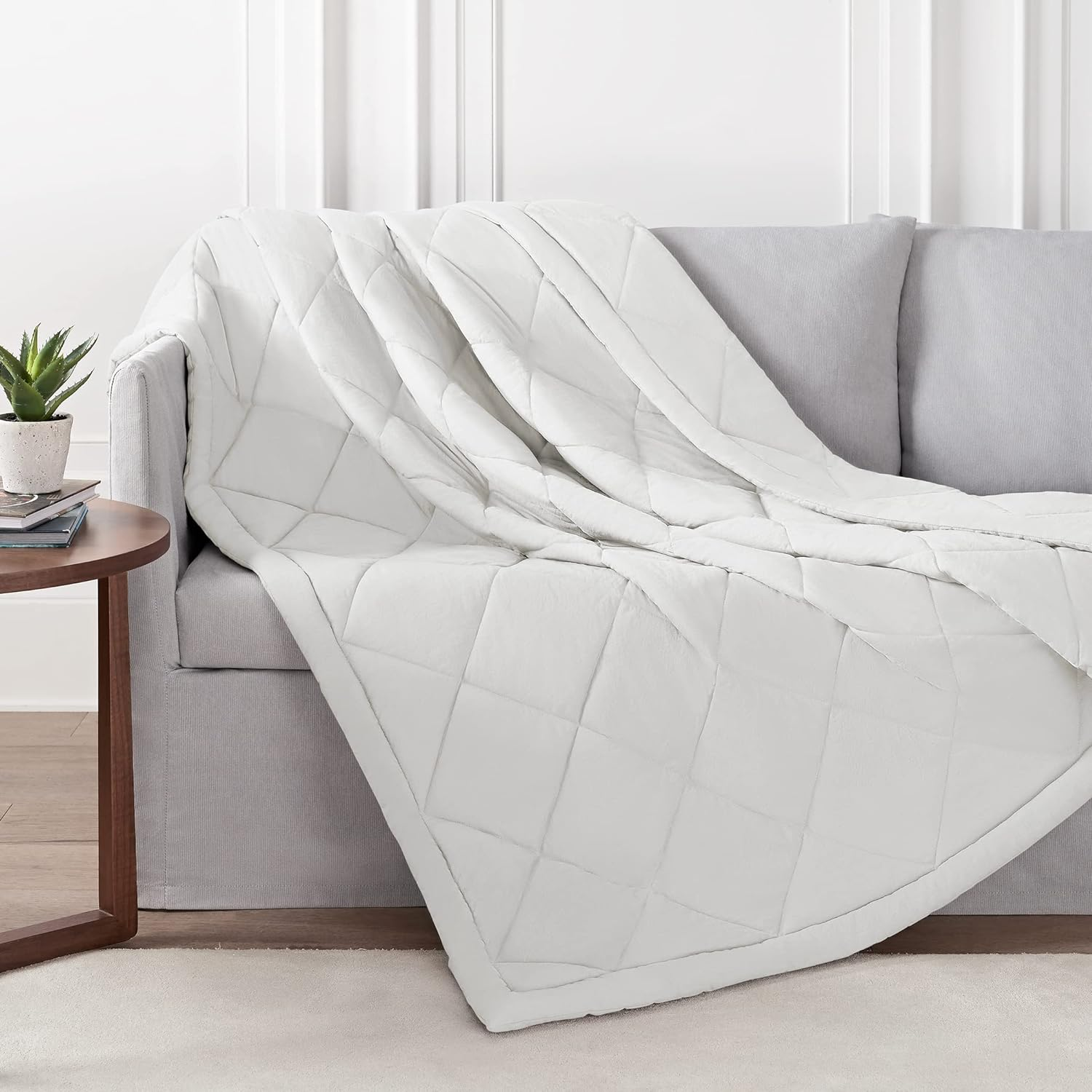What is a Cooling Blanket

- Cooling Blanket Benefits: Cooling blankets are designed to regulate body temperature during sleep, providing relief from night sweats, and hot flashes, and promoting better sleep quality. They offer advantages such as reducing anxiety, easing muscle pain, and creating a comfortable sleep environment.
- How They Work: Cooling blankets employ various technologies, including evaporative cooling, conductive cooling with materials like gel, and phase change materials (PCM). These methods help absorb and dissipate heat, ensuring a continuous cooling effect throughout the night.
- Choosing the Right One: Consider factors like climate, sleep habits, material, size, and budget when selecting a cooling blanket. Options include water-based, gel-based, PCM, and air-cooled blankets, each offering unique benefits for a personalized and comfortable sleep experience.
Cooling blankets have become a popular trend in bedding, offering a solution for those who struggle with regulating their body temperature during sleep. Whether you tend to sleep hot, experience night sweats, or suffer from medical conditions like multiple sclerosis or menopause, a cooling blanket can provide you with the comfort you need for a restful night’s sleep. In this comprehensive guide, we will delve into the world of cooling blankets, exploring their benefits, how they work, and the different types available. By the end of this article, you will have the necessary information to make a well-informed decision about which cooling blanket suits your needs.
What is a Cooling Blanket?
A cooling blanket is a form of bedding crafted to assist in regulating your body temperature during sleep. Generally filled with substances such as gel or liquid crystals, these blankets absorb and release heat, producing a cooling sensation. By drawing the excess heat away from your body, cooling blankets help you stay cool and comfortable throughout the night. They are particularly beneficial for individuals who sleep hot, experience night sweats, or suffer from medical conditions that can cause hot flashes.
How Does a Cooling Blanket Work?
Cooling blankets work by utilizing various techniques to lower your body temperature. One common method is evaporative cooling, which involves the evaporation of water to cool the body. This can be achieved by using a damp cloth or spraying the body with water. Another method is conductive and cooling technology, where materials like gel or ice transfer heat away from the body. Cooling blankets can also rely on materials with high heat conductivity, like copper or aluminum, to draw heat away from the body and provide a cooling effect.
To use a cooling blanket effectively, it should cover as much surface area of your body as possible without constricting blood flow or causing discomfort. It is essential to remove the well-weighted cooling blanket once your body temperature has returned to normal to avoid becoming too cold. The benefits of using a cooling blanket include reducing the risk of overheating, providing comfort, and helping to control pain.
See Also: The Benefits of a Weighted Blanket
The Benefits of Using a Cooling Blanket
Cooling blankets provide various advantages that can improve your sleep quality and overall well-being throughout the entire night. Let’s explore some of the key advantages:
Reducing Night Sweats
Experiencing night sweats can disturb your sleep and leave you feeling uncomfortable and soaked in sweat. Cooling blankets help regulate your body temperature, preventing excessive sweating and promoting a more comfortable sleep environment.
Regulating Body Temperature during Hot Weather
In warm weather, staying cool and comfortable, particularly at night, can be challenging. Cooling blankets provide a refreshing solution by absorbing body heat, dissipating heat, and keeping your body at an optimal temperature for restful sleep.
Easing Muscle Pain and Stiffness
If you suffer from stiffness or muscle pain, a cooling blanket can provide relief. The cooling effect helps reduce inflammation and soothe sore muscles, promoting relaxation and comfort.
Decreasing Anxiety and Promoting Relaxation
Anxiety and stress while sleeping can make it difficult to relax and fall asleep. Cooling blankets provide a soothing sensation, aiding in anxiety relief and promoting a state of relaxation, making it easier to ease into a deep and tranquil sleep.
Facilitating a Good Night’s Sleep
By removing heat and maintaining a comfortable body temperature throughout the night, cooling blankets contribute to better sleep quality. When your body is not overheated, you are more likely to experience uninterrupted sleep and wake up feeling refreshed and energized.
How to Use a Cooling Blanket
To make the most of your cooling blanket, here are some tips on how to use it effectively:
- Identify Your Needs: Determine the specific purpose for which you need a cooling blanket. Whether it’s to alleviate hot flashes, manage night sweats, or regulate body temperature during exercise, understanding your needs will help you select the right cooling blanket.
- Consider the Environment: Ensure the room you are in is well-ventilated, especially if you are using a cooling blanket at home. Good air circulation will enhance the cooling effect and provide a more comfortable sleep environment.
- Proper Placement: Place the cooling blanket on top of your sheet to prevent direct contact with your skin. This will help maintain hygiene and ensure the blanket’s effectiveness.
- Moderate Usage: Avoid using the cooling blanket for more than two hours at a time to prevent your body from becoming too cold. It is essential to find the balance between staying cool and maintaining a cozy, comfortable body temperature.
- Stay Hydrated: As the cooling blanket may cause increased sweating, it is crucial to drink plenty of fluids to stay hydrated. This will aid in regulating your body temperature and preventing dehydration.
- Listen to Your Body: If you start to feel dizzy or lightheaded while using the cooling blanket, remove it immediately and seek medical attention if necessary. It’s important to prioritize your health and well-being.
Choosing the Right Cooling Blanket

When choosing a cooling blanket, it’s important to consider several factors to make sure you select the one that suits your needs. Let’s explore some key aspects to keep in mind:
Climate Considerations
The climate you live in plays an important role in determining the type of cooling blanket that will work best for you. If you reside in a hot climate, opt for a cooling blanket specifically designed to withstand higher temperatures and provide effective cooling.
Sleep Habits
Understanding your sleep habits is crucial in selecting a cooling blanket that suits your needs. If you often experience warmth during sleep, seek out a cooling blanket with improved breathability and outstanding moisture-wicking properties to ensure you stay cool and comfortable throughout the night.
Material Matters
The material of the cooling blanket can significantly impact its cooling effectiveness. Look for materials of fabric that are known for their breathability, such as bamboo or cotton. These fabrics allow for better airflow, ensuring optimal cooling and comfort.
Size and Coverage
Ensure the cooling blanket is large enough to cover your entire body comfortably. The size and coverage will determine how effectively the cooling properties are distributed across your body, maximizing the benefits of the cold air through the blanket.
Budget Considerations
Cooling blankets come in various price ranges, depending on the type and brand. Consider your budget and prioritize the features that are most important to you. Gel-based and water-based choices are usually more budget-friendly, whereas electric blankets provide greater customization and control for temperature regulation.
By considering these factors, you can find the cooling blanket that best suits your needs, preferences, and budget.
The Different Types of Cooling Blankets
Cooling blankets come in various types, each offering unique benefits. Let’s explore the four main types:
Water-Based Cooling Blankets
Water-based cooling blankets utilize a water reservoir to circulate cold water throughout the weighted blanket. This type is commonly used in medical settings to lower a patient’s body temperature. The water circulation provides a continuous cooling effect, ensuring optimal comfort.
Gel-Based Cooling Blankets
Gel-based cooling blankets contain gel beads or similar materials that absorb body heat and dissipate it into the air. These blankets are popular among athletes for post-workout recovery, hot sleepers, and individuals experiencing hot flashes. Gel-based blankets are lightweight and portable, making them a convenient choice.
Phase Change Material (PCM) Cooling Blankets
PCM cooling blankets incorporate a special material that changes phases at specific temperatures. When the PCM material reaches its melting point, it absorbs heat from the body, delivering enduring and immediate cooling relief. PCM blankets are known for their durability and ability to maintain a consistent cooling effect.
Air-Cooled Cooling Blankets
Air-cooled cooling blankets utilize cool air to lower the temperature of both the blanket and the body. These blankets are particularly useful in hot weather climates or during power outages when air conditioning is unavailable. The flow of cool air electric cooling blankets helps regulate body temperature and ensure a comfortable sleep environment.
FAQs
Who can benefit from using a cooling blanket?
Cooling blankets are beneficial for individuals who tend to sleep hot, experience night sweats, or live in warmer climates. They are also suitable for those undergoing certain medical treatments that may cause temperature fluctuations during sleep.
Are cooling blankets suitable for year-round use?
Yes, many cooling blankets are designed for year-round use. While they excel in providing relief during warm seasons and summer, the breathable and moisture-wicking properties of these blankets also make them comfortable in cooler temperatures, ensuring versatility throughout the year.
Can a cooling blanket replace my regular blanket?
Cooling blankets can be used as a standalone bedding option or in conjunction with your regular blanket, depending on personal preference and environmental factors. Some individuals may find that using a cooling blanket alone is sufficient, while others may choose to layer it with additional bedding for extra warmth in colder conditions.
Can individuals with allergies or sensitive skin use a cooling blanket?
Many cooling blankets are made from hypoallergenic materials such as bamboo-derived fabrics or moisture-wicking textiles. These materials are often less likely to trap allergens, making these cooling fabrics and blankets a suitable choice for people with allergies or sensitive skin. However, it’s essential to check the specific materials used in the blanket to ensure compatibility with individual sensitivities.
Conclusion
Cooling blankets offer a range of benefits, from reducing night sweats to easing muscle pain and promoting relaxation. By understanding how they work and considering factors such as climate, sleep habits, and material, you can choose the right cooling blanket for your needs. Whether you choose a water-based, gel-based, PCM, or air-cooled cooling blanket, you can experience a peaceful night’s sleep and wake up feeling rejuvenated. Improve your sleep quality, manage pain effectively, and enhance your overall well-being with the help of a cooling blanket.
